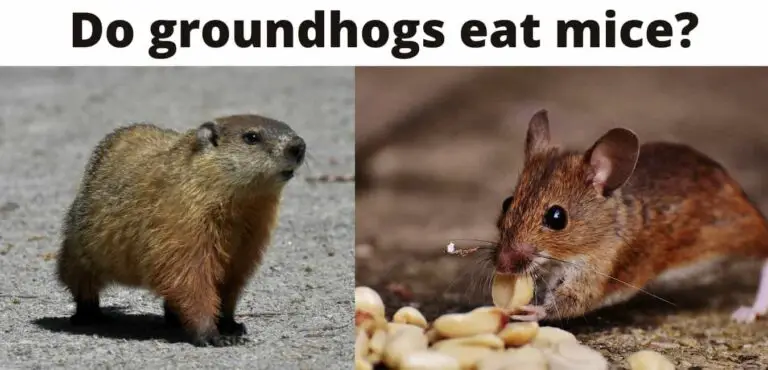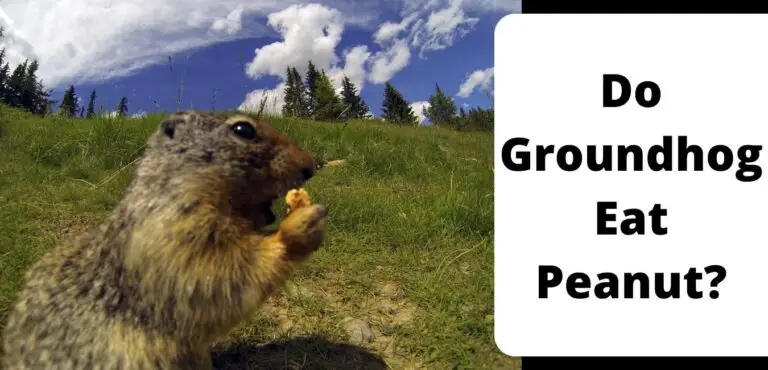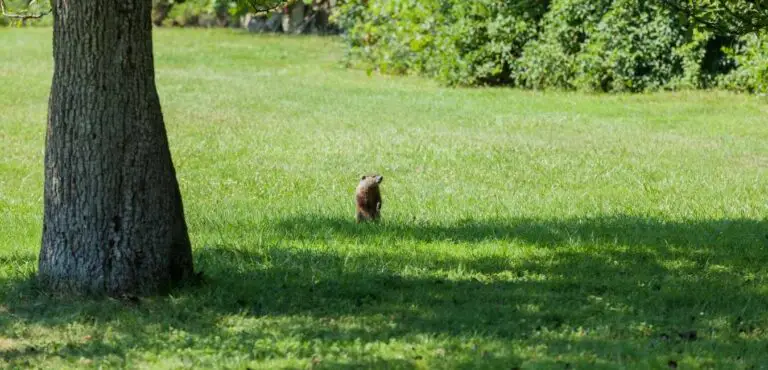Are Groundhogs Dangerous?

Yes, in a nutshell, groundhogs have been known to carry or fight with rabies, which can make them more aggressive and dangerous.
It is dangerous to us while perhaps keeping our faces near him. Groundhogs are considered pests because their feeding and transporting behaviors can cause severe damage to gardens, farms, orchards, and horticulture.
Because groundhogs infrequently contact humans, they do not pose a severe health danger.
Groundhogs rarely contact humans and offer no substantial dangers to public health. They can, however, carry microscopic insect-like fleas, ticks, and rabies.
Meanwhile, you treat it like your favorite pet and feed it properly. Suppose you can treat your Groundhog as if he were a family member. In that case, he will show you some kind that has been there in his heart, which is achievable because many Groundhogs offer it.
However, there is a common misunderstanding that when they dig themselves, they have been known to undermine building foundations, make unsightly holes in lawns, and cause power outages due to gnawing on underground lines.
Humans rarely come into contact with Earth horses. As a result, they do not offer a more significant risk to public health, so keep that in mind.
Are Groundhogs Aggressive?
Groundhogs rarely attack people. They have good human contact. It is distributed throughout Central and Eastern America and is commonly referred to as a woodchuck.
They eat through the gardens and burrow holes in the meadows. They are challenging to eliminate since they are violent creatures that can develop dementia.
According to numerous studies, the herbivore is known to be hostile and sometimes harmful among many marmot species. Inhibition of the yellow-bellied marmot and the other was delayed by one year due to wood dispersal.
It was discovered to interact with the driving intensity expressed over the years. If they are cornered or threatened, groundhogs can bite and scrape. They are calm creatures that rarely, if ever, bite.
Are Groundhogs Friendly to Humans?
Many people are unconcerned about biting on the ground. When cornered, the soil, like many other wild animals, might dry up. Although the land is only available on one line per year, finding another three sixty-four days is not difficult.
Moths can harm homeowners and farmers everywhere in the courtyard, between the road, and in the fields, roughly half of the United States and practically all of Canada. In this instance, some animals, such as cats and dogs, will bite if they are duped or surprised.
Pet cats are usually not a threat to groundhogs and can coexist. Woodchucks are highly active this time of year as they prepare to hibernate. Although loggers are susceptible to rabies, daytime activity is expected.
People may coexist peacefully with loggers since they are not aggressive and rarely spread disease. Groundhog social groupings generally have one adult male and two mature females.
Each has an offspring from the previous breeding season, which is usually a female, and the current litter of newborns. Interactions within a female group are generally pleasant.
Is it wrong to have a Groundhog in your Yard?
Is having a groundhog in your yard a bad thing?
You can get out into your yard if you have complete control over your Groundhog or if they have good interaction and proper supervision. Still, suppose you don’t have adequate control over the Groundhog. In that case, it can cause severe structural damage when burrowing in planting, woodpiles, and debris surrounding your home provides shelter for groundhogs and makes them more likely to live on your property, or you can burrow underneath the grass or some of the foundation.
They are the most prominent members of his family. Many people are curious about the column’s awesomeness because it is too large for its size. You may occasionally fall into the basement if you have a large table. If you have a garden, this is a spot for a decorative garden or a fruit tree. Knowing mara (animal name) is a simple animal that will assist you in improving your garden.
Even the greatest, like dogs, do not form a home when you associate with them. They do not anticipate being caught or captured and are not capable of doing so. Groundhogs are native to the wild.
Bringing them home entails removing them from their native environment. Taking care of these active animals can be a complex undertaking. Once a groundhog depends on its owners, it cannot survive in the wild.
Can you put a Groundhog?
The Groundhog, commonly known as the woodchuck, is highly active because it stores fat for hibernation. They can, however, contract rabies during the day.
Humans can coexist peacefully with woodchucks since they are not as aggressive as other wild animals and do not typically transfer diseases. We know it’s fantastic, but there are a few things to consider before adopting the soil as an animal.
The ground is forested. Bringing it home involves removing it from the environment. Caring for these hybrid creatures can be difficult, and if the soil is planted by its owners, it can no longer survive in the forest on its own.
Here are some things to consider if you want to acquire one. Groundhogs do not make good pets since they dig and gnaw through everything in their path. Children’s horses are particularly vulnerable and can perish if they do not get the proper treatment. Ground dogs, despite their cuteness, are not accepting pets.
It can’t fit in a little box. They must be confident that you provide adequate time to wander and explore. Groundhogs like to wreck everything! So, if they are in your house, you may say farewell to the equipment. If that’s not enough, they can sometimes break down drywall! This can not only create unneeded flu, but it is also dangerous to animals since it can destroy lines and obtain power.
Only if you are 100% committed to adopting a groundhog, have prior experience with many other animals, and have the necessary infrastructure to keep the creatures should you bring it home. Groundhogs may be pretty friendly and lively little friends if adequately trained.
Are Groundhogs Dangerous to Dogs?

When it comes to dogs, the story is somewhat different. It’s reasonable to say they didn’t like each other very much.
Dogs and mature ground dogs can cluster and become gravely hurt. It can, however, be beneficial if you have a little dog and are raising it. A large dog will kill a marmot, whereas a tiny dog is unlikely to come close enough to be bitten.
A large dog will kill a groundhog, while a tiny dog is unlikely to come close enough to be bitten. On the other hand, cats are rarely threatened by groundhogs; a cat would probably ignore it, and a groundhog will not go out of his way to attack if he is not threatened. Wear and can be chased and attacked by giant breed dogs; However, Prange can also endanger dogs; the scenario almost always ends badly for wear and tear.
Are Groundhogs Dangerous to Cats?
Cats, particularly those employed in warfare, may be mighty fighters when adequately trained. They dislike fighting dissenters, which is natural and understandable. However, anyone who has tried to trap a cat that genuinely despises you will understand how deadly this may be.
Anyone who had to transport a cat to an emergency clinic after Fluffy spent the night challenging others knows that a cat pushed too hard turns into a spinning ball that can inflict significant damage to the invisible skin.
The kitty waste that comes in is also required to keep it down. Because cats are terrestrial creatures, the smell of scattered cats can fool the earth into thinking cats are close. Spreading toxic garbage near the ground encourages animals to migrate elsewhere.
Conversely, cats are rarely intimidated by marmots, and the ground squirrel will not get out of the way to attack if it is not attacked.
Are Baby Groundhogs Dangerous?

Groundhog newborns, like human children, are extremely lively and eager. That is why they are often challenging to deal with.
It is more important to emphasize that if you find these groundhog kids and keep an eye on them for any length of time, even if they are adorable and harmless at this stage, they are wild animals and should be treated as such.
Many disasters could occur to keep her away from her den and puppies, as she is familiar with little animals. If the pups become hungry enough, they may burrow out of their den to find her, and you may come face to face with the adorable, hairless creatures.
They are not safe out in the open, and you should do everything you can to ensure that they burrow back into their den or another groundhog’s den.
Can you Touch a Groundhog?
Groundhog, this is dependent on how you connect with your Groundhog. If you take better care of your Groundhog, they will not harm you; nevertheless, if you come into close contact with a wild Groundhog, you will suffer greatly.
If you come across an adult groundhog or beaver sick or injured, do not touch or pick it up. Earthlings and beavers perceive humans as predators and would defend themselves if they believe they are in danger. They have strong jaws and sharp teeth, and they bite themselves!
It’s uncommon for a baby ground or beaver to emerge from its burrow, especially if it’s a tiny bit with closed eyes. If you see mom around, look everywhere; if not, check the infant to ensure the baby is alive and well. If you touch the baby, wear gloves.
If you are hurt, phone your local hospital or doctor for assistance, wait for help, or follow their directions to ensure that the infant arrives at the site without exacerbating the injury. If the newborn does not have a visible lesion, it is critical that the baby feels warm very away. Wrap it in a towel or blanket and, if feasible, place it over the fire pads.
Are Groundhogs Good for Anything?
Are groundhogs useful in any way?
Groundhogs will eat anything and everything you’ve planted. They are primarily vegetarian and consist of leaves, flowers, and grasses.
They are particularly fond of garden vegetables such as beans, carrots, and peas. They will also climb trees to consume apples and pears.
Groundhogs play an essential role in the food chain. They can, however, consume items that people can consume, such as gnats, other insects, and snails. They have been observed feeding on bird feeders and other small animals, primarily vegetarians; groundhogs transport varied foods from the garden to the garden.
They can, however, consume items that people can consume, such as gnats, other insects, and snails. They have also been observed eating baby birds and other small animals. Groundhogs have few predators, including coyotes, foxes, domestic dogs, and, of course, humans, because of their relatively big adult size and burrowing ability, not to mention climbing and swimming abilities.
Amazing Facts about Groundhogs
Incredible Groundhog Facts
Groundhog Underground predators are terrified of predators such as wolves, foxes, and dogs, and the odor of their urine serves as a signal to keep away. Cereals, like most people, dislike spicy foods; therefore, sprinkle red pepper powder or water and pepper near tunnels and openings.
Both male and female groundhogs are prone to this behavior. Occupying the same territories years later, there is minimal overlap between home ranges for FEMALES except in the late spring and early Territories.
Groundhogs can live up to six years in the wild, with two or three types. In captivity, groundhogs can live up to 14 years of reproducing. Except in the spring, when a litter of one to six young is born, litters of four to six young are born, and scraps of one to nine have been recorded.
Groundhogs are regarded as unṣṣappealing pests because their eating and drinking habits can severely damage home gardens, farms, orchards, and crops. Because the Groundhog rarely interacts with humans, it poses little hazard to public health. Groundhogs are native to the wild.
Bringing them home entails removing them from their native environment. Taking care of these active animals can be a complex undertaking. Once a groundhog depends on its owners, it cannot survive in the wild.
Home for Groundhogs
The immediate opening of the underground pit can be a foot wide and is usually identified by a massive pile of buried dirt. It has the potential to be an actual “ankle snail.” There may also be two or more hole openings.
The total system can be up to five feet tall and more than thirty feet long. The main nest box is grass-lined. Groundhogs are considered unappealing pests because their eating and drinking habits can severely damage home gardens, farms, orchards, and crops. Because the Groundhog rarely interacts with humans, it poses little hazard to public health.
Many disasters could occur to keep her away from her den and puppies, as she is familiar with little animals. If the pups become hungry enough, they may burrow out of their den to find her, and you may come face to face with the adorable, hairless creatures.
They are not safe out in the open, and you should do everything you can to ensure that they burrow back into their den or another groundhog’s den.






